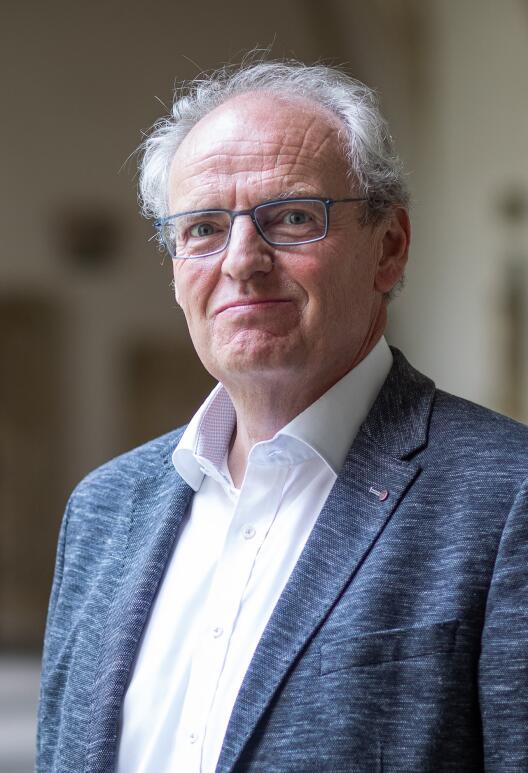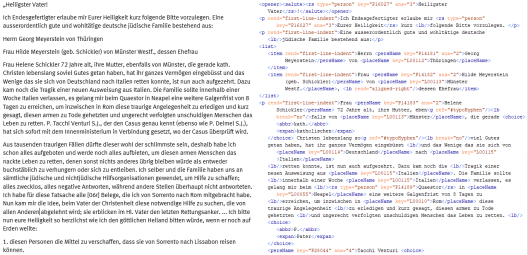„In bitterer Not wende ich mich an Eure Heiligkeit.“
Interview with Prof. Dr. Hubert Wolf about digital humanities methods in the research project "Asking the Pope for Help”

The “Asking the Pope for Help” project is analyzing all the petitions that Jewish people sent to Pope Pius XII and the Church during the Shoah. Besides these petitions, the project is also editing documents in the Vatican archives that relate to the respective “cases”, and will make extensive teaching materials available at a later date. The lecture will use a number of examples to illustrate how the project’s database and web app work, and the DH methods that underpin such a project.
What is the focus of your DH project at the Cluster of Excellence, and what question do you hope to answer using DH methods?
Around 15,000 Jewish people from all over Europe asked Pope Pius XII and the Vatican for help during the Nazi regime. They wrote mainly in Italian, German and French, but also in almost all other European languages. In highly emotional first-person documents, they describe their life stories, their hardship and the suffering inflicted on them, but also their scope for action during the Shoah. Previously unknown, the letters can be found in the files from the pontificate of Pius XII (1939-1958) in various Vatican archives. In a project funded by the “Remembrance, Responsibility and Future” (EVZ) Foundation, we are identifying the approximately 6,000 petitions known to date and the 15,000 people mentioned in them, and making these petitions openly accessible in a digital edition (https://www.uni-muenster.de/FB2/aph/index.html). Around 2,000 petitions have already been documented and will be available at www.askingthepopeforhelp.de from mid-2024. As part of a sub-project at the Cluster of Excellence, we are analyzing the petitions and the relevant correspondence from Romania and Brazil in terms of particular research questions.
Since the letters reveal the entire diversity of “being Jewish” at that time, we will also focus on the affiliations of the petitioners in terms of the research paradigm of ‘Belonging’. For example, some people of Jewish descent were baptized and saw themselves primarily as Catholics, while others explicitly supported fascism and were nevertheless persecuted as Jews. We will use methods from the Digital Humanities to analyze these descriptions of self and others, and relate the descriptions to each other.
Using DH methods, we will be able to answer not just one, but a whole host of questions. These questions begin in a very small way: How many letters are there? Which letters were answered, and which simply discarded without any action being taken? Which letters were presented to the Pope, and how many? ... And the questions become bigger: How many Jewish people did the Holy See help between 1939 and 1945? How did it help? Which countries did the people come from, and were they all baptized? Did the people see themselves as Jews or Catholics? Which routes did they use during their flight? In short, these documents tell us new things about Pius XII’s attitude to the Holocaust, and about how the Roman Curia functioned. The project also performs a paradigm shift away from the Pope, who was dependent on the preparatory work of his staff, and towards the decision-making processes in the Curia and the religious orders involved.

What do the DH methods actually look like when you use them in your project?
Our DP infrastructure works like a small factory: the front door is the Oxygen software, into which we enter the documents found in the archives in the XML markup language. We use the TEI standard as a general framework, but this had to be adapted to the project’s specific needs. We used as a basis the ediarum software package, which is a project of the Berlin-Brandenburg Academy of Sciences and Humanities. Among other things, this provides ready-made TEI-compliant XML structures for letters. With this tool, we can, for example, assign our own analysis categories to individual terms from the petition such as “Jew”.
The author mode for Oxygen contained in ediarum enables us to leave the often confusing code view of the XML files, transcribe the documents in a clear Word-like view, and carry out the labelling of persons, locations and analysis categories semi-automatically. This greatly reduces the chance of errors.
The files created and edited in Oxygen are then stored in our database. For this so-called backend system, i.e. the technology that is behind everything, we can largely rely on openly accessible software (such as eXist). With their help, we can, for example, automatically create our own registers for individuals or places.
In addition, ediarum provides a programming interface, known as an API. This enables communication between different programmes. To do this, eXist converts the data into a format that is independent of programming language and standardized internationally. We can now process this data further and use it to create complex statistics or display locations mentioned in the documents on maps and thus visualize the escape routes of one or more people or networks of people.
However, this is where ediarum’s support ends for us. While ediarum continues to use X technologies for the website, we do not use them at all. This is mainly due to the fact that they are used almost exclusively in humanities research, but are a marginal phenomenon in the rest of the IT world, which is why we rely on more common programming languages. This approach has the great advantage that the software company SAP, which is a partner in developing the programme, can also support the project team in terms of content if required.
How are or were these methods developed?
An external programmer and our project’s own system developer are constantly adapting and developing this ediarum software package. We are benefiting from the experience gained from our three previous DFG long-term projects, and in particular from the “Critical Online Edition of the Nunciature Reports of Eugenio Pacelli (1917-1929)”, where we developed a dynamic view for documents that have been corrected several times, the so-called layer model. At the end of the dynamic process is a customized database.
What findings are already available, and what findings do you expect? What would the same research look like without DH methods?
After almost two years of work, our database now contains 3,209 transcribed documents. We can already say that the Vatican helped both baptized and non-baptized Jews. And that, even if the Pope himself did not publicly comment on the Holocaust, the Vatican did act in some way in at least 80% of cases when asked.
Based on the petitions that have been edited so far, we can also make some statements about the letters and their authors. Most are written in Italian, German and French, but English, Latin, Polish, Portuguese, Romanian, Hungarian and Hebrew are also used. We can already evaluate the religious affiliation of the people who turned to the Pope, which will help us to analyze, for example, possible differences in how Catholics of Jewish origin or devout Jews were treated. We already know from the letters that the life worlds of those persecuted as Jewish were by no means as homogeneous as the literature suggests. One aim of the project is to analyze this variance further. In addition, we are already marking the places mentioned in the letters and can thus visualize the escape routes that people used. And we can already visualize in our internal web app the family relationships of the people named in the letters. All this means that the project would not be possible without digital methods and aids.
What is the social relevance of this research today, and what value do the DH methods have in this respect?
Given the resurgence of antisemitism, and especially among young people, it is vital to deal with and reappraise the petitions didactically, and a fundamental aim of the project is to make the stories of these people accessible to researchers, descendants and the public. Directly described in highly emotional first-person documents, the individual fates offer enormous potential for this. Hence, we are enriching the historical perspective with a didactic approach and insights from communication science. This helps us to analyze the potential of digital teaching materials developed on the basis of the sources and their historical development for remembrance work and combating antisemitism, for constructing identity and promoting democracy. We also use DH methods here – for example, in preparing teaching materials and incorporating social media. The DH methods make it possible for us in the first place to process such a large corpus of sources and ultimately make them available digitally.

